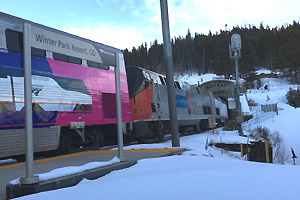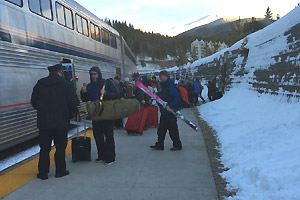Winter Park Express facts for kids

Winter Park Express stopped at the resort, just past the Moffat Tunnel west portal, January 2018
|
|
| Overview | |
|---|---|
| Service type | Inter-city rail |
| Status | Seasonal (January–March) |
| Locale | Colorado |
| First service | 1940 |
| Current operator(s) | Amtrak |
| Former operator(s) | Rio Grande |
| Annual ridership | 18,996 (FY2019) |
| Route | |
| Start | Denver, Colorado |
| End | Winter Park Resort, Colorado |
| Distance travelled | 56 miles (90 km) |
| Average journey time | 2 hours, 15 minutes |
| Service frequency | Friday, Saturday, Sunday |
| Train number(s) | 1105 (westbound) 1106 (eastbound) |
| Line used | UP Central Corridor |
| On-board services | |
| Class(es) | Coach Class |
| Disabled access | Train lower level, all stations |
| Catering facilities | Café |
| Observation facilities | Sightseer lounge car |
| Baggage facilities | Overhead racks, dedicated storage for skis |
| Technical | |
| Rolling stock | GE Genesis Superliner |
| Track gauge | 4 ft 8 1⁄2 in (1,435 mm) standard gauge |
The Winter Park Express is a special passenger train. It runs on winter weekends. The train travels between Denver Union Station and Winter Park Resort in Colorado. It's operated by Amtrak.
This train takes you on a beautiful 56-mile trip. It climbs 4,000 feet into the Front Range mountains. You'll go through 30 tunnels, including the famous 6.2-mile Moffat Tunnel. This tunnel goes right under the Continental Divide. The train drops you off super close to the ski lifts at Winter Park. It runs on Fridays, Saturdays, and Sundays from January to March.
This train route used to be called the Ski Train. The Denver and Rio Grande Western Railroad started it in 1940. That's when the ski area first opened. Later, a company called Ansco Investment Company ran the Ski Train until 2009. They stopped because it became too expensive. Amtrak brought the train back in 2017. People really wanted it back after some special trips in 2015 sold out fast!
Contents
History of the Ski Train
Early Days: Rio Grande Operation (1940–1988)
The Ski Train began in 1940. It was started by the Denver and Rio Grande Western Railroad. This company was often called the Rio Grande.
The train made one trip each way every day. The ride usually took about 2 hours and 15 minutes. Sometimes, freight trains caused delays.
In the 1960s, the Ski Train was very popular. Trains with 22 cars carried about 1,800 passengers. Many of these passengers were young people. Sometimes, there were problems on the train. Once, a young person pulled the emergency brake. This caused damage to the train. After that, the railroad hired sheriff's deputies. They helped patrol the train and keep things safe.
For a while in the early 1970s, the train also stopped in the Rocky Flats area.
Ansco Investment Company Takes Over (1988–2009)

In 1988, a company called Ansco Investment Company bought the train operation. They made many improvements. They ran the "New Ski Train" for 20 years.
During this time, the Ski Train had three locomotives. These are the engines that pull the train. It also had fourteen cars. These included eight regular passenger cars, three club cars, and two cafe lounge cars. There was also one special "retreat" car. The train could carry 750 passengers.
Sometimes, the train faced challenges. On January 21, 2006, a coal train had an accident. This blocked the tracks. About 700 passengers were stuck in Winter Park. Buses were sent to take them back to Denver. Just two months later, on March 19, another freight train accident happened. This delayed the Ski Train for almost six hours. The train arrived in Denver around midnight.
In 2007, a big snowstorm hit. This forced the train to cancel service on December 29 and 30.
The Ski Train made its last trip on March 29, 2009. It had become too expensive to run. Costs like insurance and conflicts with freight trains were a problem. Also, the Denver Union Station was being redeveloped. This created more uncertainty. The global financial crisis also made things harder. So, the Ski Train stopped running.
The train cars were sold to another company. They were refurbished and are now used on a tourist train in Canada.
Amtrak Brings Back the Train: The Winter Park Express (2015–Present)
In February 2015, Amtrak, Winter Park Resort, and the Union Pacific Railroad had exciting news. They announced a special one-day "Winter Park Express" train. It would run on Saturday, March 14. This was to celebrate Winter Park's 75th birthday. Tickets cost $75. All 400 seats sold out in just 12 hours! Because it was so popular, a second train was added for Sunday, March 15. It also sold out very quickly.
People were very excited about the train. This gave hope that the Ski Train would return. It would run seasonally from the new Denver Union Station. Amtrak and Winter Park officials met. They worked on a plan to run at least two trips a week. This would be from January to March 2016. However, they couldn't make it happen for 2016. But all groups kept talking.
In August 2016, Amtrak announced regular Winter Park Express service. It would run on weekends from January through March 2017. In its first full season, the train made 25 trips. It carried 18,000 passengers. About 30% of these passengers were not skiers. The train had one big problem on March 11, 2017. A freight train accident forced the cancellation of the Saturday trip.
After a great first season, more service was added for 2017–18. This included Friday trips and cheaper tickets for some dates. For the 2018–19 season, Amtrak added a Superliner Sightseer lounge and café car. This car has food and drinks. It also has huge windows for amazing views. Riders had asked for this upgrade the most. For the 2019–20 season, which was Winter Park's 80th, service was added for every Friday.
In March 2020, the Winter Park Express stopped running. This was due to the COVID-19 pandemic. The train did not run in the 2020–21 season. Amtrak reported that nearly 70,000 people rode the train. This was from its start in 2017 until the 2020 stop.
In November 2021, Amtrak and Winter Park Resort announced the train would return. It came back for the 2021–22 season. The train now runs on its 2019 schedule. This means Friday, Saturday, and Sunday service. It runs from mid-January through early April.
Future Plans for Rail Service
In June 2021, Colorado created a new district. Its goal is to develop Front Range Passenger Rail. This would be a new train service. It would connect cities like Pueblo, Colorado Springs, Denver, Boulder, and Fort Collins. The plan specifically mentions connecting with the Winter Park Express. Many people who support trains see the Winter Park Express as a way to build interest. It helps show how useful a Front Range train service could be.
The Train Route
The Winter Park Express starts at Union Station in Denver, Colorado. It travels 56 miles to Winter Park Resort in the town of Winter Park. There are no stops in between.
As the train heads west from Denver, it climbs 3,960 feet. It goes up the Front Range mountains. It passes through 29 tunnels. This area is called the "Tunnel District." You'll see places like Plainview, Crescent, Wondervu, and the Gross Reservoir areas. Then, it generally follows South Boulder Creek. It goes through Pinecliffe, Tolland, and Rollinsville.
The last big mountain tunnel is the 6.2-mile Moffat Tunnel. This tunnel goes under the Continental Divide. It is the highest railroad tunnel in the United States. It's also the third-longest. Only the Cascade Tunnel in Washington and the Flathead Tunnel in Montana are longer.
On weekdays and during the off-season, you can still reach Winter Park by train. Amtrak's long-distance California Zephyr runs daily. It uses the same route from Denver. However, it does not stop directly at Winter Park Resort. Instead, you can get off a few miles down the track. This is at the Fraser–Winter Park station. From there, local buses called "The Lift" connect you to the resort. So, you have two train options to travel between Denver and Winter Park when the Winter Park Express is running.




